The Cambridge History of Japan, Vol. 1: Ancient Japan
Подождите немного. Документ загружается.

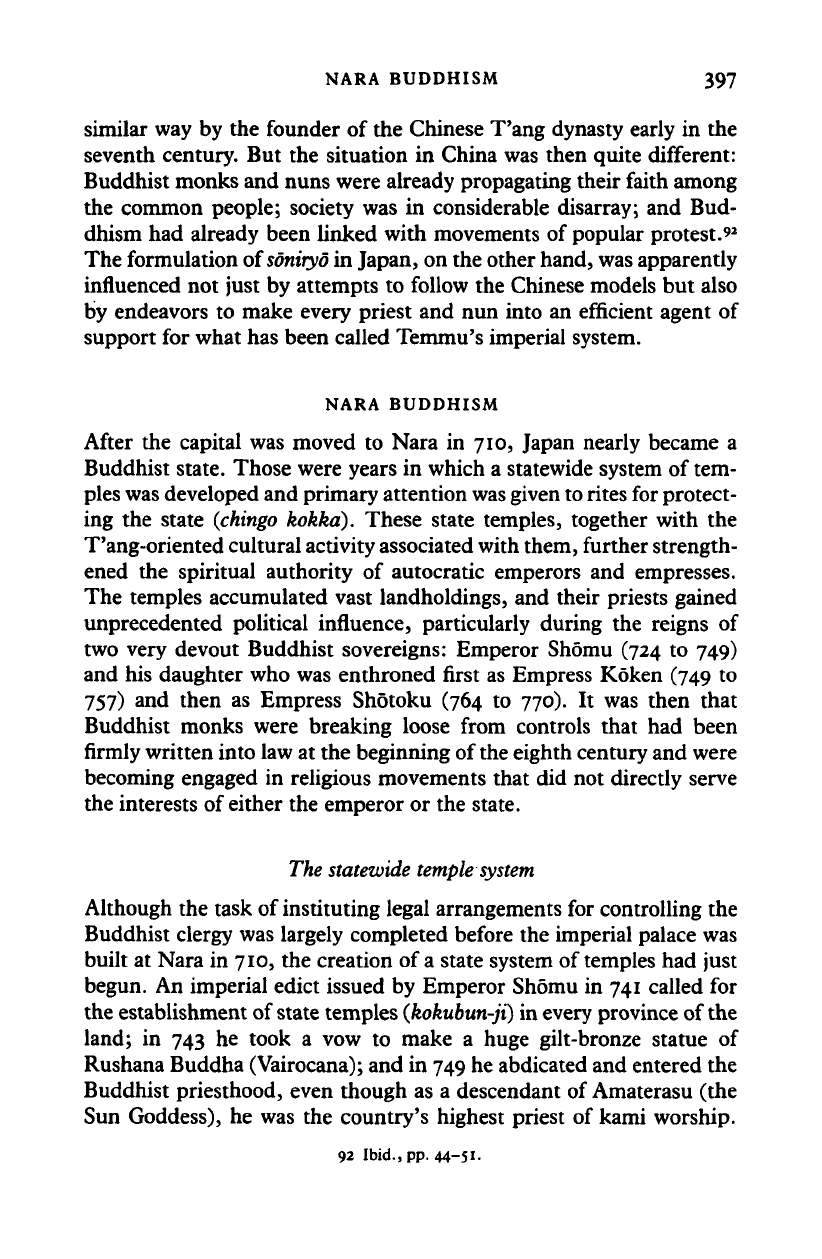
NARA BUDDHISM 397
similar way by the founder of the Chinese T'ang dynasty early in the
seventh century. But the situation in China was then quite different:
Buddhist monks and nuns were already propagating their faith among
the common people; society was in considerable disarray; and Bud-
dhism had already been linked with movements of popular protest.
92
The formulation of
soniryo
in Japan, on the other hand, was apparently
influenced not just by attempts to follow the Chinese models but also
by endeavors to make every priest and nun into an efficient agent of
support for what has been called Temmu's imperial system.
NARA BUDDHISM
After the capital was moved to Nara in 710, Japan nearly became a
Buddhist state. Those were years in which a statewide system of tem-
ples was developed and primary attention
was
given to rites for protect-
ing the state
(chingo
kokka). These state temples, together with the
T'ang-oriented cultural activity associated with them, further strength-
ened the spiritual authority of autocratic emperors and empresses.
The temples accumulated vast landholdings, and their priests gained
unprecedented political influence, particularly during the reigns of
two very devout Buddhist sovereigns: Emperor Shomu (724 to 749)
and his daughter who was enthroned first as Empress Koken (749 to
757) and then as Empress Shotoku (764 to 770). It was then that
Buddhist monks were breaking loose from controls that had been
firmly written into law at the beginning of the eighth century and were
becoming engaged in religious movements that did not directly serve
the interests of either the emperor or the state.
The statewide temple
system
Although the task of instituting legal arrangements for controlling the
Buddhist clergy was largely completed before the imperial palace was
built at Nara in 710, the creation of
a
state system of temples had just
begun. An imperial edict issued by Emperor Shomu in 741 called for
the establishment of state temples
(kokubun-ji)
in every province of the
land; in 743 he took a vow to make a huge gilt-bronze statue of
Rushana Buddha (Vairocana); and in 749 he abdicated and entered the
Buddhist priesthood, even though as a descendant of Amaterasu (the
Sun Goddess), he was the country's highest priest of kami worship.
92 Ibid., pp.
44-51.
Cambridge Histories Online © Cambridge University Press, 2008
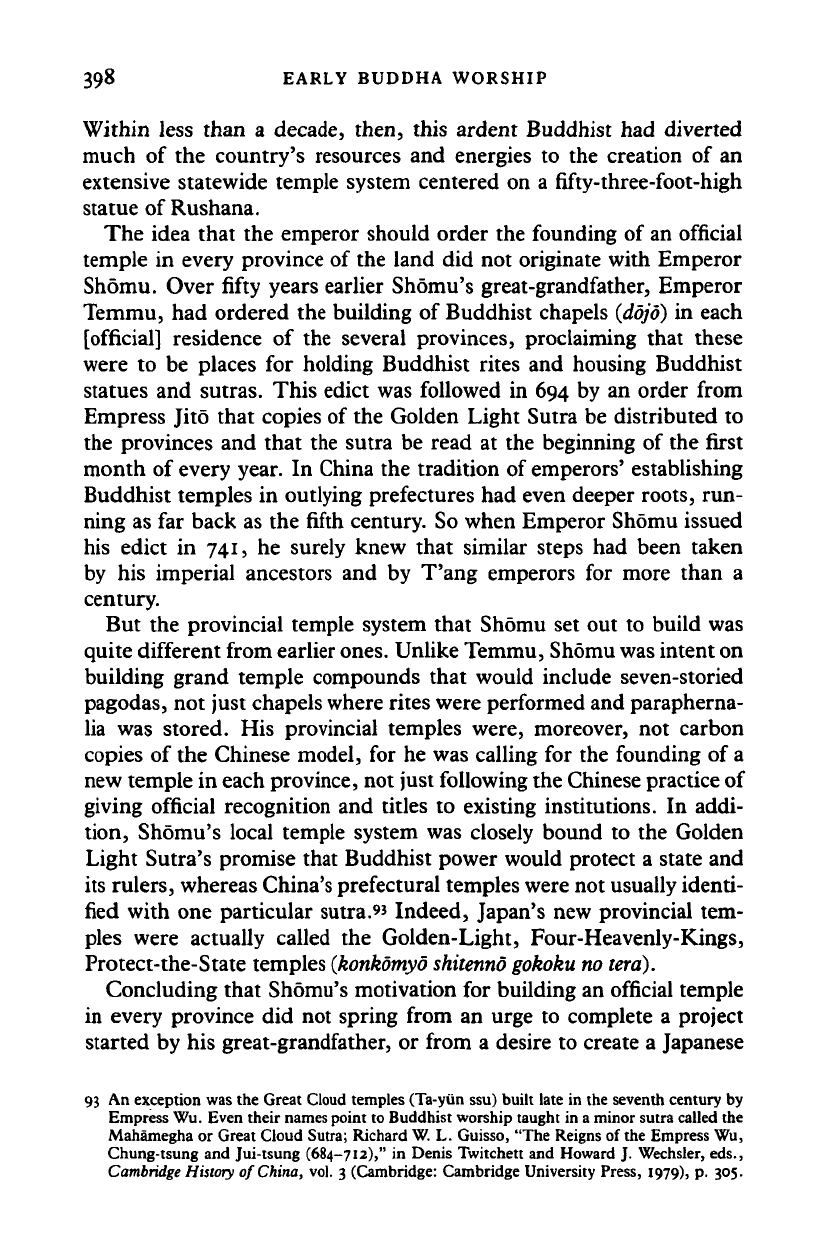
398 EARLY BUDDHA WORSHIP
Within less than a decade, then, this ardent Buddhist had diverted
much of the country's resources and energies to the creation of an
extensive statewide temple system centered on a fifty-three-foot-high
statue of Rushana.
The idea that the emperor should order the founding of an official
temple in every province of the land did not originate with Emperor
Shomu. Over fifty years earlier Shomu's great-grandfather, Emperor
Temmu, had ordered the building of Buddhist chapels
(dojo)
in each
[official] residence of the several provinces, proclaiming that these
were to be places for holding Buddhist rites and housing Buddhist
statues and sutras. This edict was followed in 694 by an order from
Empress Jito that copies of the Golden Light Sutra be distributed to
the provinces and that the sutra be read at the beginning of the first
month of every year. In China the tradition of emperors' establishing
Buddhist temples in outlying prefectures had even deeper roots, run-
ning as far back as the fifth century. So when Emperor Shomu issued
his edict in 741, he surely knew that similar steps had been taken
by his imperial ancestors and by T'ang emperors for more than a
century.
But the provincial temple system that Shomu set out to build was
quite different from earlier
ones.
Unlike Temmu, Shomu was intent on
building grand temple compounds that would include seven-storied
pagodas, not just chapels where rites were performed and parapherna-
lia was stored. His provincial temples were, moreover, not carbon
copies of the Chinese model, for he was calling for the founding of a
new temple in each province, not just following the Chinese practice of
giving official recognition and titles to existing institutions. In addi-
tion, Shomu's local temple system was closely bound to the Golden
Light Sutra's promise that Buddhist power would protect a state and
its rulers, whereas China's prefectural temples were not usually identi-
fied with one particular sutra." Indeed, Japan's new provincial tem-
ples were actually called the Golden-Light, Four-Heavenly-Kings,
Protect-the-State temples
(konkomyo shitenno gokoku no
tera).
Concluding that Shomu's motivation for building an official temple
in every province did not spring from an urge to complete a project
started by his great-grandfather, or from a desire to create a Japanese
93 An exception was the Great Cloud temples (Ta-yiin ssu) built late in the seventh century by
Empress Wu. Even their names point to Buddhist worship taught in a minor sutra called the
Mahamegha or Great Cloud Sutra; Richard
W.
L. Guisso, "The Reigns of the Empress Wu,
Chung-tsung and Jui-tsung (684-712)," in Denis Twitchett and Howard J. Wechsler, eds.,
Cambridge History
of
China,
vol. 3 (Cambridge: Cambridge University Press, 1979), p. 305.
Cambridge Histories Online © Cambridge University Press, 2008
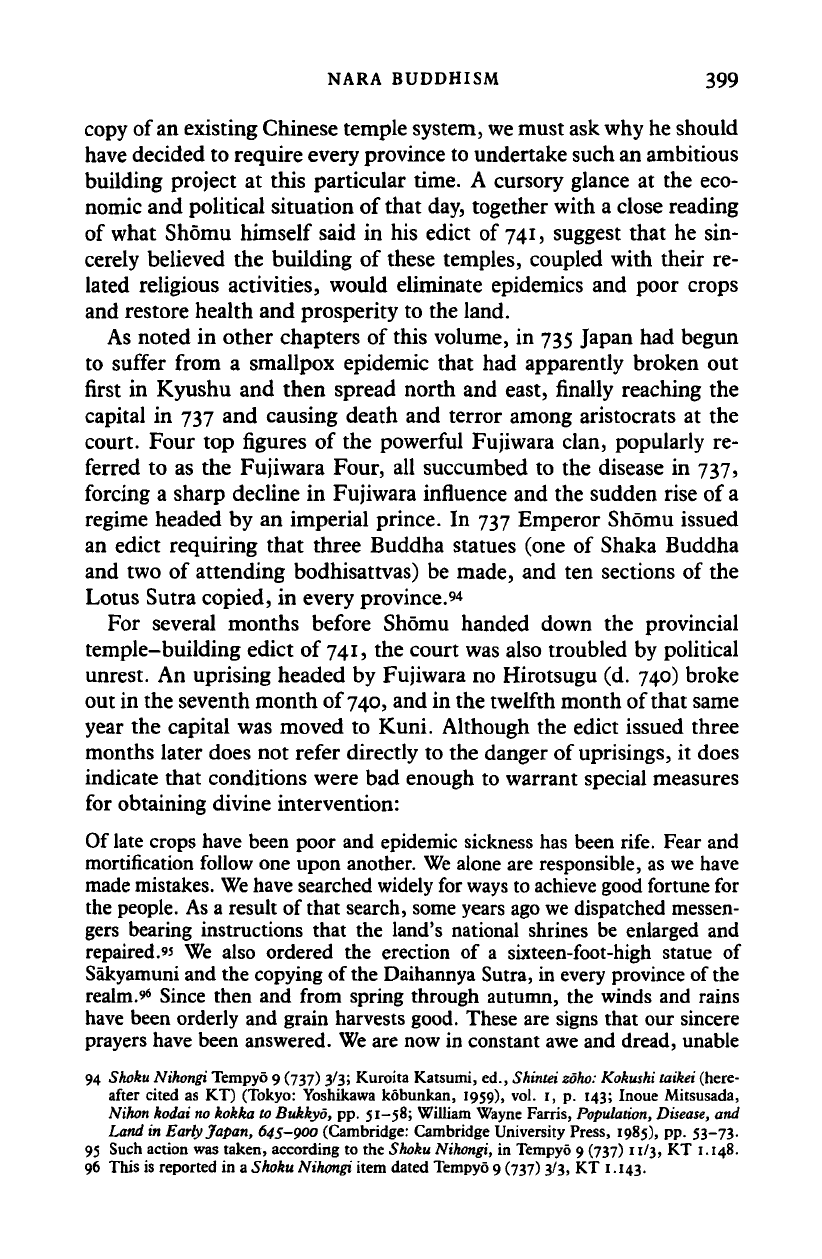
NARA BUDDHISM 399
copy of an existing Chinese temple system, we must ask why he should
have decided to require every province to undertake such an ambitious
building project at this particular time. A cursory glance at the eco-
nomic and political situation of that day, together with a close reading
of what Shomu himself said in his edict of 741, suggest that he sin-
cerely believed the building of these temples, coupled with their re-
lated religious activities, would eliminate epidemics and poor crops
and restore health and prosperity to the land.
As noted in other chapters of this volume, in 735 Japan had begun
to suffer from a smallpox epidemic that had apparently broken out
first in Kyushu and then spread north and east, finally reaching the
capital in 737 and causing death and terror among aristocrats at the
court. Four top figures of the powerful Fujiwara clan, popularly re-
ferred to as the Fujiwara Four, all succumbed to the disease in 737,
forcing a sharp decline in Fujiwara influence and the sudden rise of a
regime headed by an imperial prince. In 737 Emperor Shomu issued
an edict requiring that three Buddha statues (one of Shaka Buddha
and two of attending bodhisattvas) be made, and ten sections of the
Lotus Sutra copied, in every provinces
For several months before Shomu handed down the provincial
temple-building edict of
741,
the court was also troubled by political
unrest. An uprising headed by Fujiwara no Hirotsugu (d. 740) broke
out in the seventh month of
740,
and in the twelfth month of that same
year the capital was moved to Kuni. Although the edict issued three
months later does not refer directly to the danger of uprisings, it does
indicate that conditions were bad enough to warrant special measures
for obtaining divine intervention:
Of late crops have been poor and epidemic sickness has been rife. Fear and
mortification follow one upon another. We alone are responsible, as we have
made mistakes.
We
have searched widely for
ways
to achieve good fortune for
the people. As a result of that search, some years ago we dispatched messen-
gers bearing instructions that the land's national shrines be enlarged and
repaired.** We also ordered the erection of a sixteen-foot-high statue of
Sakyamuni and the copying of
the
Daihannya Sutra, in every province of the
realm.9
6
Since then and from spring through autumn, the winds and rains
have been orderly and grain harvests good. These are signs that our sincere
prayers have been answered. We are now in constant awe and dread, unable
94 Shoku Nihongi Tempyo 9 (737) 3/3; Kuroita Katsumi, ed., Shintei zoho: Kokushi taikei (here-
after cited as KT) (Tokyo: Yoshikawa kobunkan, 1959), vol. 1, p. 143; Inoue Mitsusada,
Nihon kodai no kokka to Bukkyo, pp. 51-58; William Wayne Farris, Population, Disease, and
Land in Early Japan, 64S-900 (Cambridge: Cambridge University Press, 1985), pp.
53—73.
95 Such action was taken, according to the Shoku Nihongi, in Tempyo 9 (737) 11/3, KT
1.148.
96 This is reported in a Shoku Nihongi item dated Tempyo 9 (737) 3/3, KT 1.143.
Cambridge Histories Online © Cambridge University Press, 2008
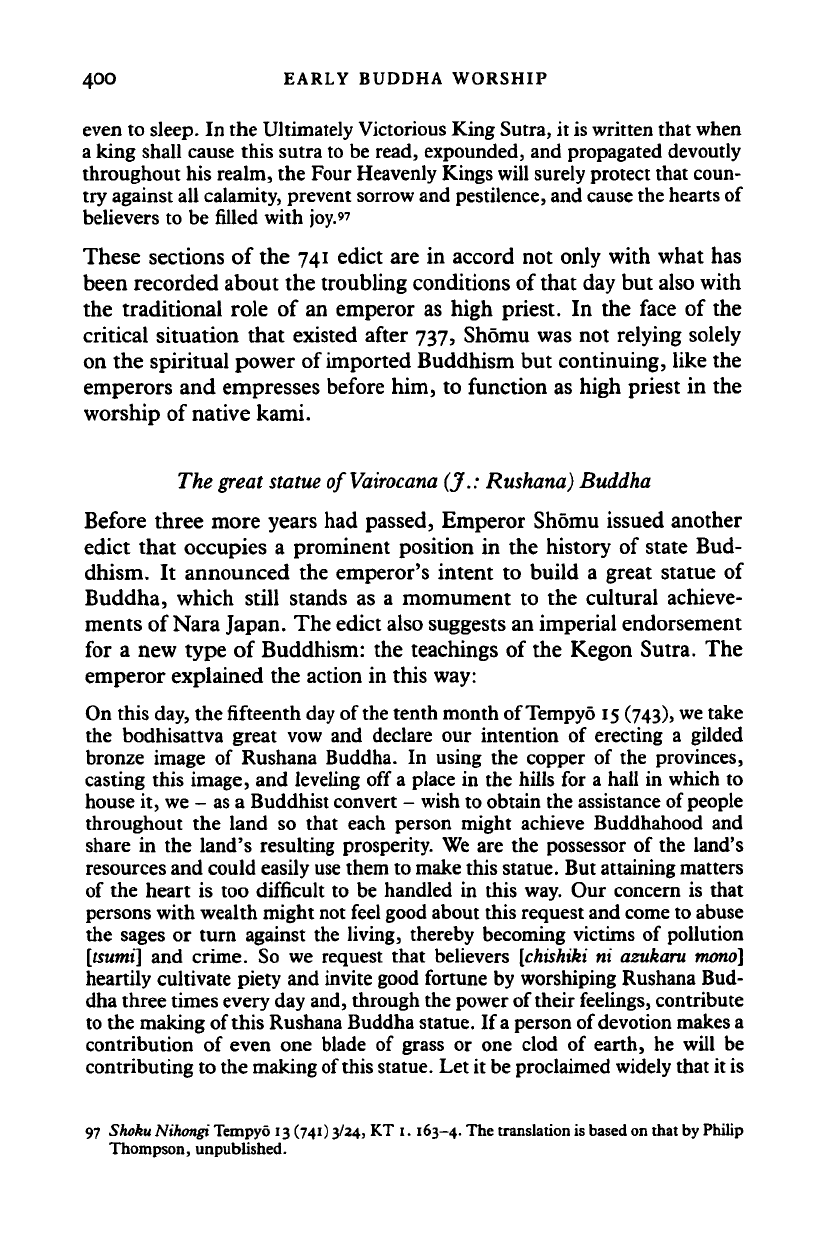
40O EARLY BUDDHA WORSHIP
even
to
sleep. In the Ultimately Victorious King Sutra,
it
is written that when
a king shall cause this sutra to
be
read, expounded, and propagated devoutly
throughout his realm,
the
Four Heavenly Kings will surely protect that coun-
try against all calamity, prevent sorrow and pestilence, and cause the hearts of
believers
to be
filled
with
joy."
These sections of the 741 edict are in accord not only with what has
been recorded about the troubling conditions of that day but also with
the traditional role of an emperor as high priest. In the face of the
critical situation that existed after 737, Shomu was not relying solely
on the spiritual power of imported Buddhism but continuing, like the
emperors and empresses before him, to function as high priest in the
worship of native kami.
The great statue ofVairocana
(J.:
Rushana) Buddha
Before three more years had passed, Emperor Shomu issued another
edict that occupies a prominent position in the history of state Bud-
dhism. It announced the emperor's intent to build a great statue of
Buddha, which still stands as a momument to the cultural achieve-
ments of Nara Japan. The edict also suggests an imperial endorsement
for a new type of Buddhism: the teachings of the Kegon Sutra. The
emperor explained the action in this way:
On this day,
the
fifteenth day of
the
tenth month of Tempyo
15
(743),
we take
the bodhisattva great
vow and
declare
our
intention
of
erecting
a
gilded
bronze image
of
Rushana Buddha.
In
using
the
copper
of the
provinces,
casting this image,
and
leveling
off
a place
in the
hills
for a
hall
in
which
to
house
it,
we
-
as
a
Buddhist convert
-
wish to obtain the assistance of people
throughout
the
land
so
that each person might achieve Buddhahood
and
share
in the
land's resulting prosperity.
We are the
possessor
of the
land's
resources and could easily use them to make this statue. But attaining matters
of
the
heart
is too
difficult
to be
handled
in
this way.
Our
concern
is
that
persons with wealth might not feel good about this request and come to abuse
the sages
or
turn against
the
living, thereby becoming victims
of
pollution
[tsumi]
and
crime.
So we
request that believers
[chishiki
ni
azukaru mono]
heartily cultivate piety and invite good fortune
by
worshiping Rushana Bud-
dha three times every day and, through the power of their feelings, contribute
to the making of this Rushana Buddha statue.
If
a
person of devotion makes a
contribution
of
even
one
blade
of
grass
or one
clod
of
earth,
he
will
be
contributing to the making of this statue. Let it be proclaimed widely that it
is
97 Shoku Nihongi Tempyo 13 (741) 3/24,
KT 1.
163-4.
The
translation
is
based on that
by
Philip
Thompson, unpublished.
Cambridge Histories Online © Cambridge University Press, 2008
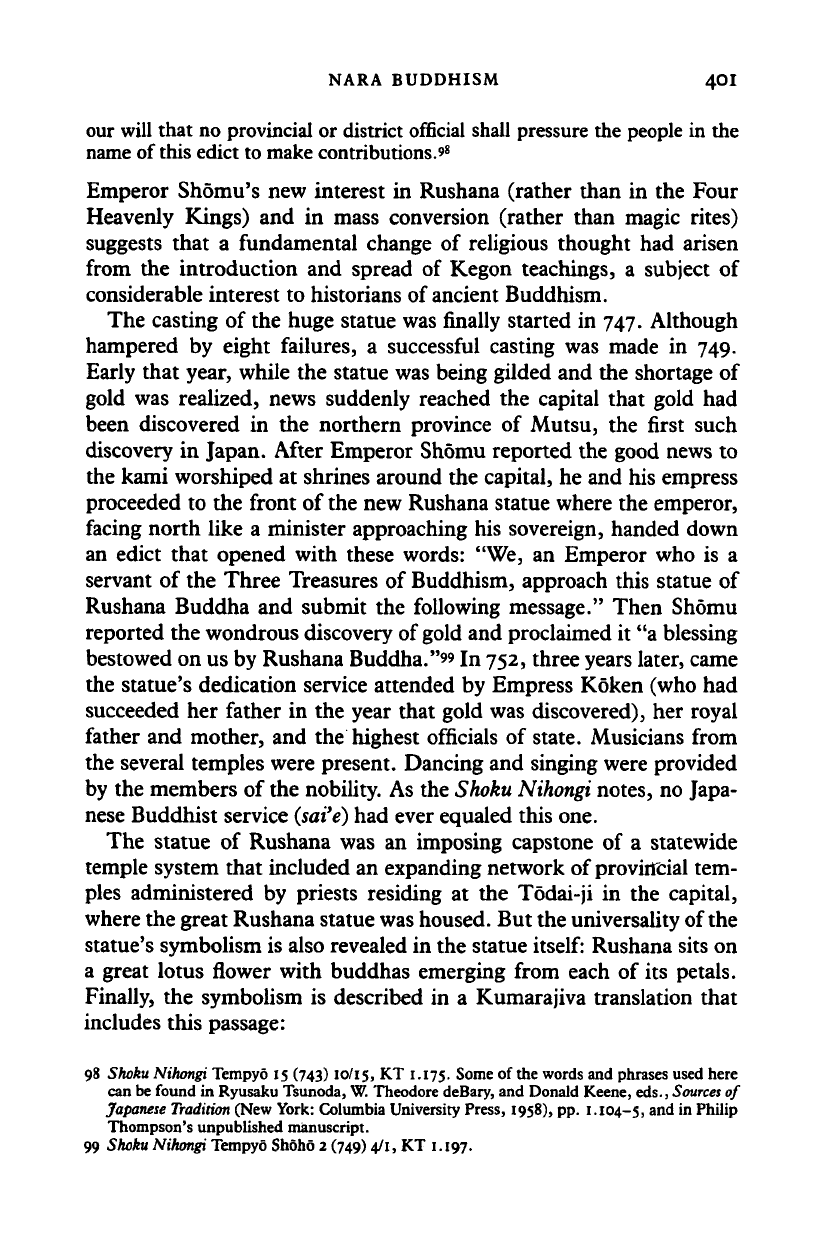
NARA BUDDHISM 401
our will that no provincial or district official shall pressure the people in the
name of this edict to make contributions.'
8
Emperor Shomu's new interest in Rushana (rather than in the Four
Heavenly Kings) and in mass conversion (rather than magic rites)
suggests that a fundamental change of religious thought had arisen
from the introduction and spread of Kegon teachings, a subject of
considerable interest to historians of ancient Buddhism.
The casting of the huge statue was finally started in 747. Although
hampered by eight failures, a successful casting was made in 749.
Early that year, while the statue was being gilded and the shortage of
gold was realized, news suddenly reached the capital that gold had
been discovered in the northern province of Mutsu, the first such
discovery in Japan. After Emperor Shomu reported the good news to
the kami worshiped at shrines around the capital, he and his empress
proceeded to the front of the new Rushana statue where the emperor,
facing north like a minister approaching his sovereign, handed down
an edict that opened with these words: "We, an Emperor who is a
servant of the Three Treasures of Buddhism, approach this statue of
Rushana Buddha and submit the following message." Then Shomu
reported the wondrous discovery of gold and proclaimed it "a blessing
bestowed on us by Rushana Buddha."»In 752, three years later, came
the statue's dedication service attended by Empress Koken (who had
succeeded her father in the year that gold was discovered), her royal
father and mother, and the highest officials of state. Musicians from
the several temples were present. Dancing and singing were provided
by the members of the nobility. As the Shoku
Nihongi
notes, no Japa-
nese Buddhist service
(sai'e)
had ever equaled this one.
The statue of Rushana was an imposing capstone of a statewide
temple system that included an expanding network of provincial tem-
ples administered by priests residing at the Todai-ji in the capital,
where the great Rushana statue was housed. But the universality of the
statue's symbolism is also revealed in the statue
itself:
Rushana sits on
a great lotus flower with buddhas emerging from each of its petals.
Finally, the symbolism is described in a Kumarajiva translation that
includes this passage:
98 Shoku Nihongi Tempyo 15 (743) 10/15, K.T
1.175.
Some of the words and phrases used here
can be found in Ryusaku Tsunoda, W. Theodore deBary, and Donald Keene, eds., Sources of
Japanese Tradition (New York: Columbia University Press, 1958), pp. 1.104-5, and
m
Philip
Thompson's unpublished manuscript.
99 Shoku Nihongi Tempyo Shoho 2 (749)
4/1,
KT
1.197.
Cambridge Histories Online © Cambridge University Press, 2008
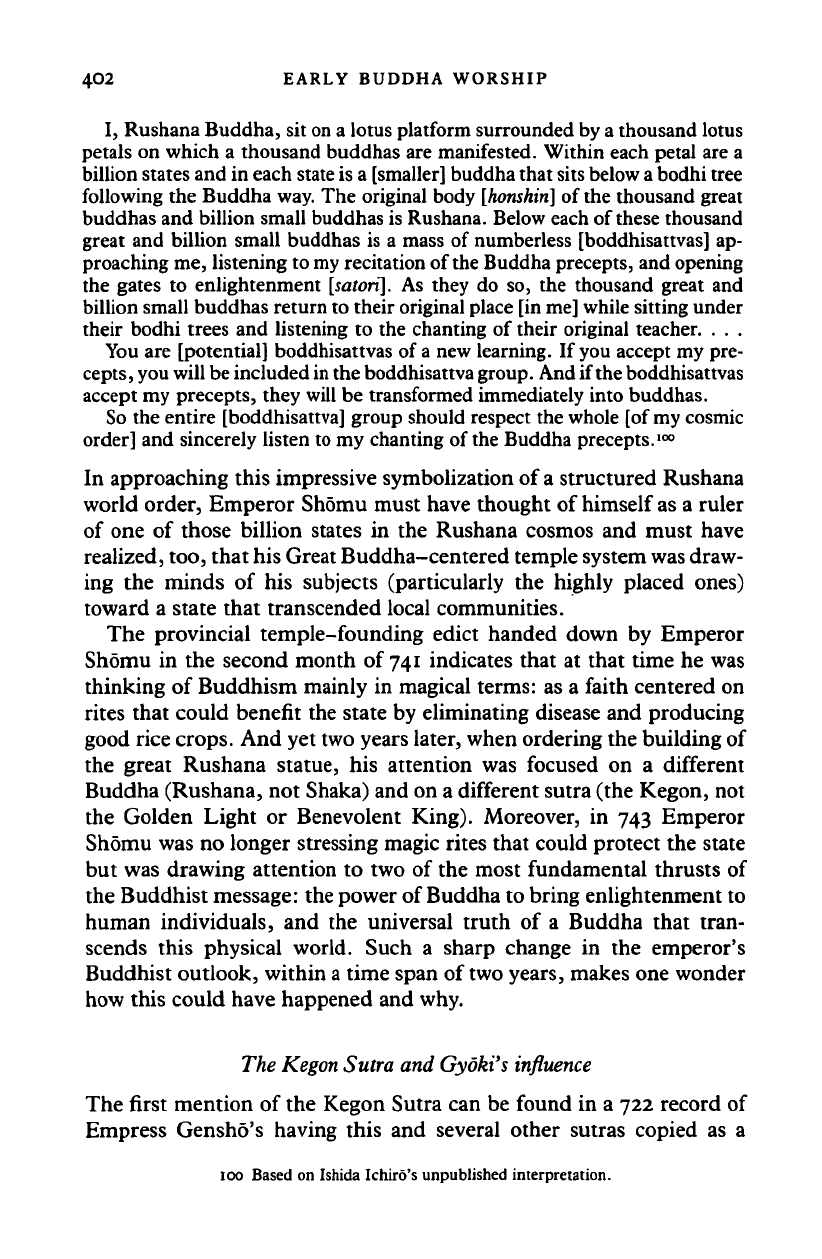
402 EARLY BUDDHA WORSHIP
I, Rushana Buddha, sit on a lotus platform surrounded by a thousand lotus
petals on which a thousand buddhas are manifested. Within each petal are a
billion states and in each state is a [smaller] buddha that sits below
a
bodhi tree
following the Buddha way. The original body
[honshin]
of
the
thousand great
buddhas and billion small buddhas is Rushana. Below each of
these
thousand
great and billion small buddhas is a mass of numberless [boddhisattvas] ap-
proaching me, listening to my recitation of the Buddha precepts, and opening
the gates to enlightenment
[satori].
As they do so, the thousand great and
billion small buddhas return to their original place [in
me]
while sitting under
their bodhi trees and listening to the chanting of their original teacher. . . .
You are [potential] boddhisattvas of
a
new learning. If you accept my pre-
cepts,
you will be included
in
the boddhisattva
group.
And if the boddhisattvas
accept my precepts, they will be transformed immediately into buddhas.
So the entire [boddhisattva] group should respect the whole [of my cosmic
order] and sincerely listen to my chanting of the Buddha precepts.
100
In approaching this impressive symbolization of a structured Rushana
world order, Emperor Shomu must have thought of himself as a ruler
of one of those billion states in the Rushana cosmos and must have
realized, too, that his Great Buddha-centered temple system was draw-
ing the minds of his subjects (particularly the highly placed ones)
toward a state that transcended local communities.
The provincial temple-founding edict handed down by Emperor
Shomu in the second month of 741 indicates that at that time he was
thinking of Buddhism mainly in magical terms: as a faith centered on
rites that could benefit the state by eliminating disease and producing
good rice crops. And yet two years later, when ordering the building of
the great Rushana statue, his attention was focused on a different
Buddha (Rushana, not Shaka) and on a different sutra (the Kegon, not
the Golden Light or Benevolent King). Moreover, in 743 Emperor
Shomu was no longer stressing magic rites that could protect the state
but was drawing attention to two of the most fundamental thrusts of
the Buddhist message: the power of Buddha to bring enlightenment to
human individuals, and the universal truth of a Buddha that tran-
scends this physical world. Such a sharp change in the emperor's
Buddhist outlook, within a time span of two years, makes one wonder
how this could have happened and why.
The Kegon Sutra and Gyoki's influence
The first mention of the Kegon Sutra can be found in a 722 record of
Empress Gensho's having this and several other sutras copied as a
100 Based on Ishida Ichiro's unpublished interpretation.
Cambridge Histories Online © Cambridge University Press, 2008
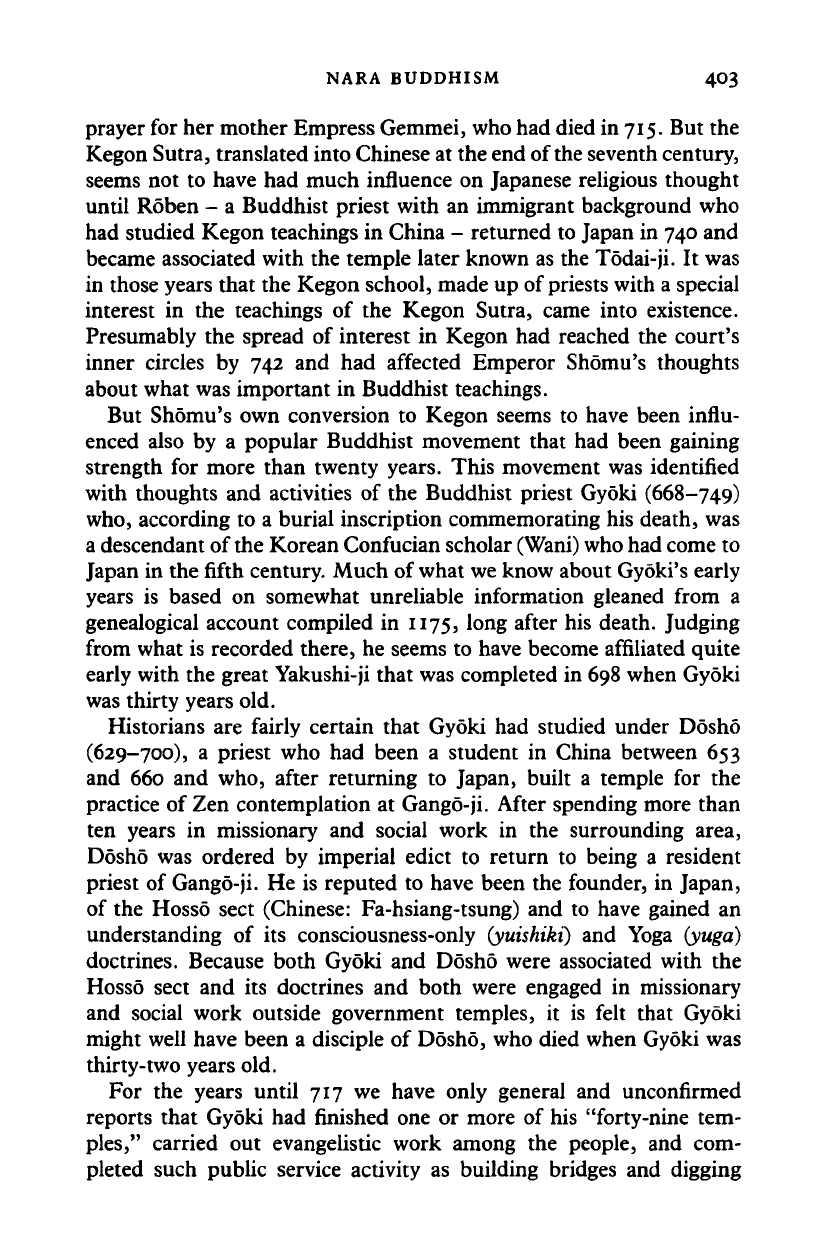
NARA BUDDHISM 403
prayer for her mother Empress Gemmei, who had died in
715.
But the
Kegon Sutra, translated into Chinese at the end of the seventh century,
seems not to have had much influence on Japanese religious thought
until Roben - a Buddhist priest with an immigrant background who
had studied Kegon teachings in China - returned to Japan in 740 and
became associated with the temple later known as the Todai-ji. It was
in those years that the Kegon school, made up of priests with a special
interest in the teachings of the Kegon Sutra, came into existence.
Presumably the spread of interest in Kegon had reached the court's
inner circles by 742 and had affected Emperor Shomu's thoughts
about what was important in Buddhist teachings.
But Shomu's own conversion to Kegon seems to have been influ-
enced also by a popular Buddhist movement that had been gaining
strength for more than twenty years. This movement was identified
with thoughts and activities of the Buddhist priest Gyoki (668-749)
who,
according to a burial inscription commemorating his death, was
a descendant of the Korean Confucian scholar (Wani) who had come to
Japan in the fifth century. Much of what we know about Gyoki's early
years is based on somewhat unreliable information gleaned from a
genealogical account compiled in 1175, long after his death. Judging
from what is recorded there, he seems to have become affiliated quite
early with the great Yakushi-ji that was completed in 698 when Gyoki
was thirty years old.
Historians are fairly certain that Gyoki had studied under Dosho
(629-700), a priest who had been a student in China between 653
and 660 and who, after returning to Japan, built a temple for the
practice of Zen contemplation at Gango-ji. After spending more than
ten years in missionary and social work in the surrounding area,
Dosho was ordered by imperial edict to return to being a resident
priest of Gango-ji. He is reputed to have been the founder, in Japan,
of the Hosso sect (Chinese: Fa-hsiang-tsung) and to have gained an
understanding of its consciousness-only (yuishikt) and Yoga (yuga)
doctrines. Because both Gyoki and Dosho were associated with the
Hosso sect and its doctrines and both were engaged in missionary
and social work outside government temples, it is felt that Gyoki
might well have been a disciple of Dosho, who died when Gyoki was
thirty-two years old.
For the years until 717 we have only general and unconfirmed
reports that Gyoki had finished one or more of his "forty-nine tem-
ples,"
carried out evangelistic work among the people, and com-
pleted such public service activity as building bridges and digging
Cambridge Histories Online © Cambridge University Press, 2008
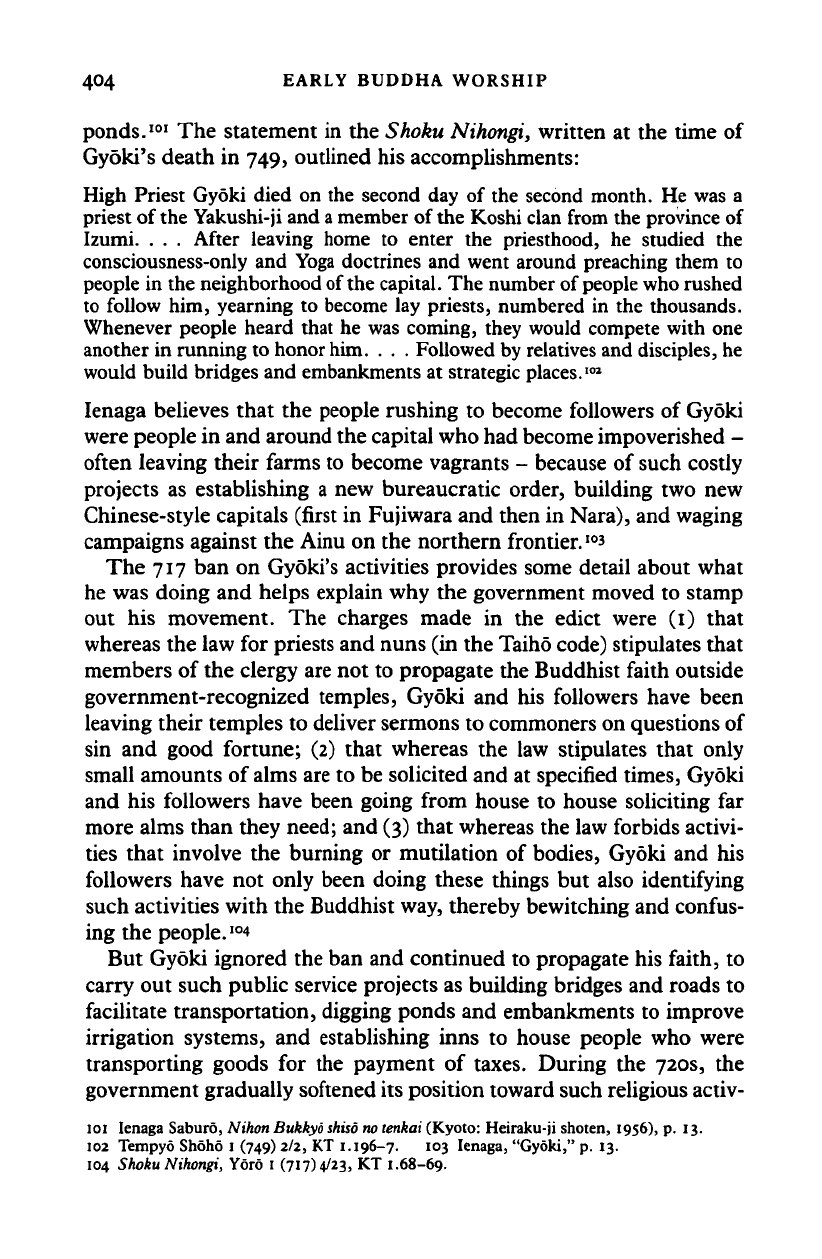
404 EARLY BUDDHA WORSHIP
ponds.
101
The statement in the Shoku Nihongi, written at the time of
Gyoki's death in 749, outlined his accomplishments:
High Priest Gyoki died on the second day of the second month. He was a
priest of the Yakushi-ji and
a
member of the Koshi clan from the province of
Izumi. . . . After leaving home to enter the priesthood, he studied the
consciousness-only and Yoga doctrines and went around preaching them to
people in the neighborhood of the capital. The number of
people
who rushed
to follow him, yearning to become lay priests, numbered in the thousands.
Whenever people heard that he was coming, they would compete with one
another in running to honor
him.
. . . Followed by relatives and disciples, he
would build bridges and embankments at strategic places.
101
Ienaga believes that the people rushing to become followers of Gyoki
were people in and around the capital who had become impoverished -
often leaving their farms to become vagrants - because of such costly
projects as establishing a new bureaucratic order, building two new
Chinese-style capitals (first in Fujiwara and then in Nara), and waging
campaigns against the Ainu on the northern frontier.
103
The 717 ban on Gyoki's activities provides some detail about what
he was doing and helps explain why the government moved to stamp
out his movement. The charges made in the edict were (1) that
whereas the law for priests and nuns (in the Taiho code) stipulates that
members of the clergy are not to propagate the Buddhist faith outside
government-recognized temples, Gyoki and his followers have been
leaving their temples to deliver sermons to commoners on questions of
sin and good fortune; (2) that whereas the law stipulates that only
small amounts of alms are to be solicited and at specified times, Gyoki
and his followers have been going from house to house soliciting far
more alms than they need; and (3) that whereas the law forbids activi-
ties that involve the burning or mutilation of bodies, Gyoki and his
followers have not only been doing these things but also identifying
such activities with the Buddhist way, thereby bewitching and confus-
ing the people.
10
*
But Gyoki ignored the ban and continued to propagate his faith, to
carry out such public service projects as building bridges and roads to
facilitate transportation, digging ponds and embankments to improve
irrigation systems, and establishing inns to house people who were
transporting goods for the payment of taxes. During the 720s, the
government gradually softened its position toward such religious activ-
101 Ienaga Saburo, Nihon Bukkyo
shiso no
tenkai (Kyoto: Heiraku-ji shoten, 1956), p. 13.
102 Tempyo Shoho 1 (749) 2/2, KT 1.196-7. 103 Ienaga, "Gyoki," p. 13.
104 Shoku Nihongi, Yoro 1 (717)4/23, KT 1.68-69.
Cambridge Histories Online © Cambridge University Press, 2008
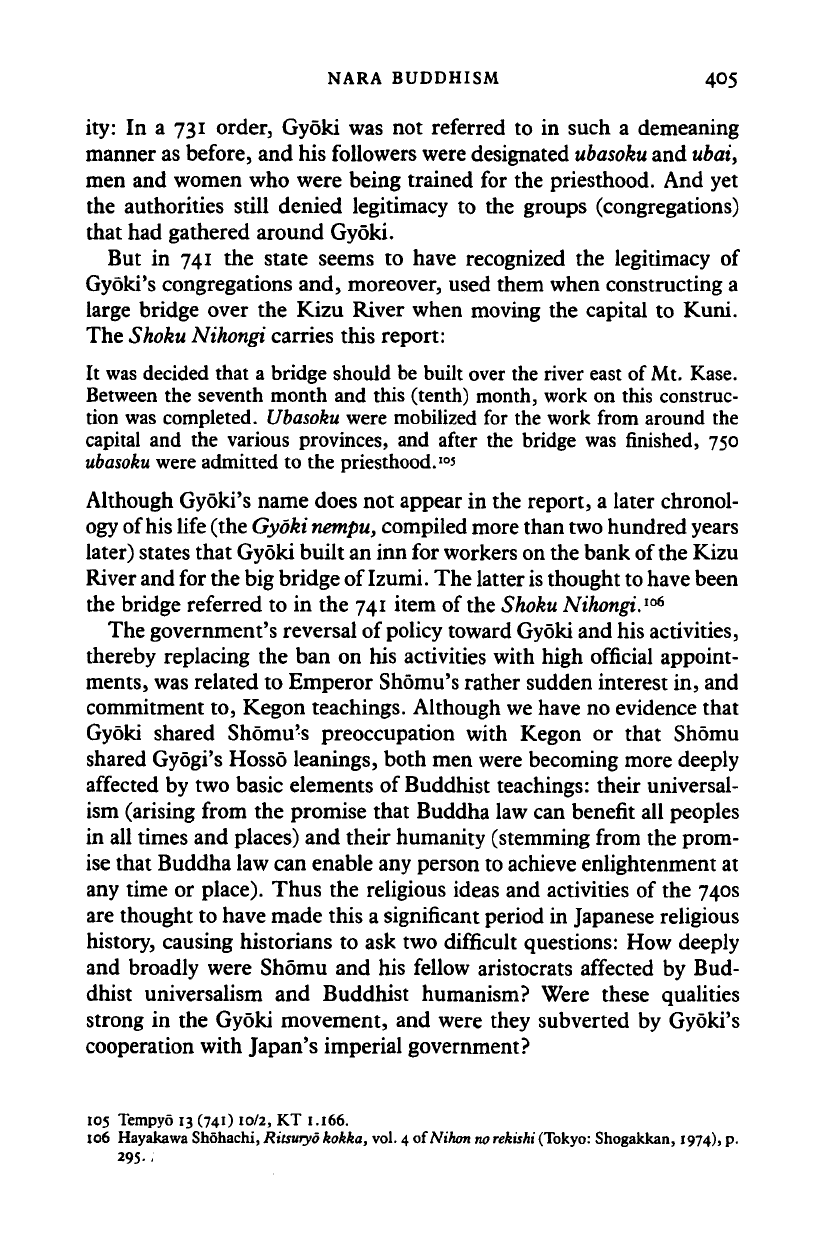
NARA BUDDHISM 405
ity: In a 731 order, Gyoki was not referred to in such a demeaning
manner as before, and his followers were designated ubasoku and ubai,
men and women who were being trained for the priesthood. And yet
the authorities still denied legitimacy to the groups (congregations)
that had gathered around Gyoki.
But in 741 the state seems to have recognized the legitimacy of
Gyoki's congregations and, moreover, used them when constructing a
large bridge over the Kizu River when moving the capital to Kuni.
The Shoku Nihongi carries this report:
It was decided that a bridge should be built over the river east of Mt. Kase.
Between the seventh month and this (tenth) month, work on this construc-
tion was completed.
Ubasoku
were mobilized for the work from around the
capital and the various provinces, and after the bridge was finished, 750
ubasoku
were admitted to the priesthood.
10
'
Although Gyoki's name does not appear in the report, a later chronol-
ogy of his life (the Gyoki nempu, compiled more than two hundred years
later) states that Gyoki built an inn for workers on the bank of the Kizu
River and for the big bridge of Izumi. The latter is thought to have been
the bridge referred to in the 741 item of the Shoku Nihongi.
106
The government's reversal of policy toward Gyoki and his activities,
thereby replacing the ban on his activities with high official appoint-
ments, was related to Emperor Shomu's rather sudden interest in, and
commitment to, Kegon teachings. Although we have no evidence that
Gyoki shared Shomu's preoccupation with Kegon or that Shomu
shared Gyogi's Hosso leanings, both men were becoming more deeply
affected by two basic elements of Buddhist teachings: their universal-
ism (arising from the promise that Buddha law can benefit all peoples
in all times and places) and their humanity (stemming from the prom-
ise that Buddha law can enable any person to achieve enlightenment at
any time or place). Thus the religious ideas and activities of the 740s
are thought to have made this a significant period in Japanese religious
history, causing historians to ask two difficult questions: How deeply
and broadly were Shomu and his fellow aristocrats affected by Bud-
dhist universalism and Buddhist humanism? Were these qualities
strong in the Gyoki movement, and were they subverted by Gyoki's
cooperation with Japan's imperial government?
105 Tempyo 13 (741) 10/2, KT 1.166.
106 Hayakawa Shohachi, Ritswyo kokka, vol. 4 oiNihon
no rekishi
(Tokyo:
Shogakkan, 1974), p.
295-
•
Cambridge Histories Online © Cambridge University Press, 2008
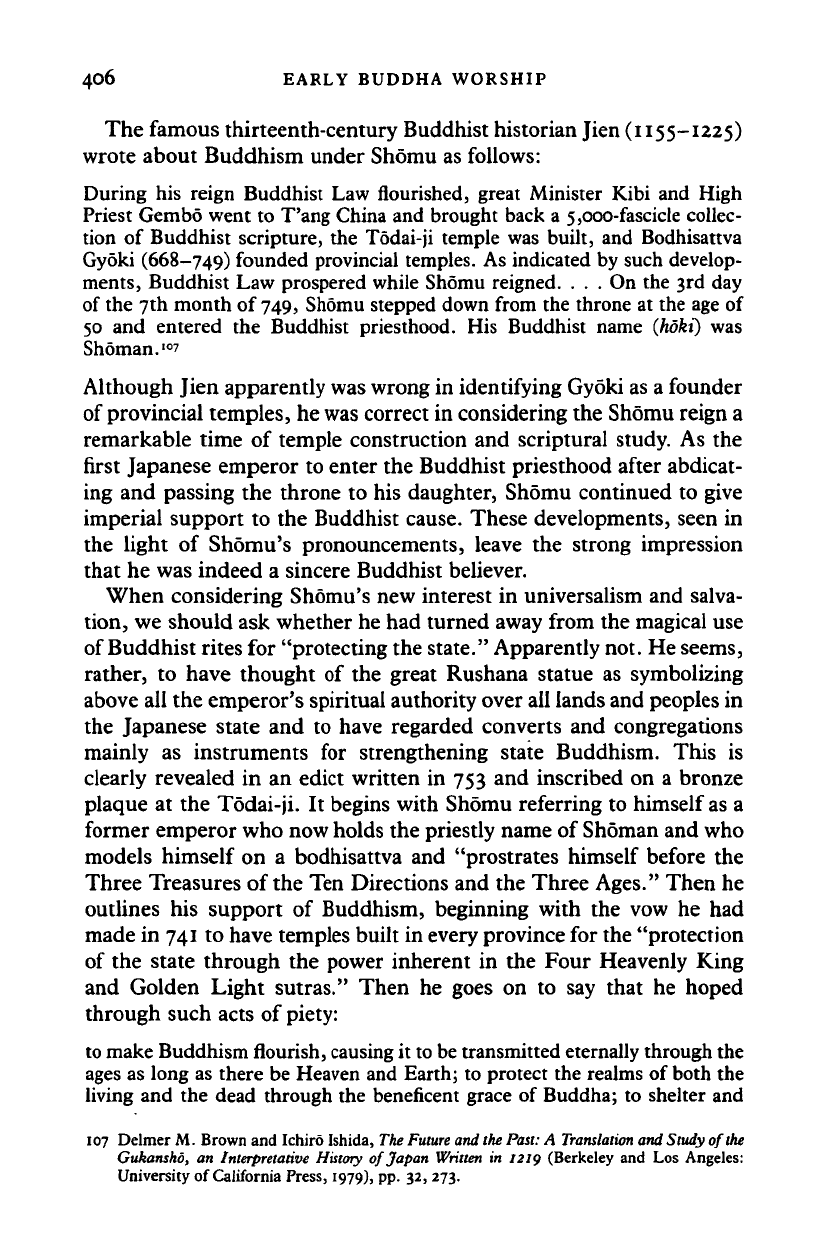
406 EARLY BUDDHA WORSHIP
The famous thirteenth-century Buddhist historian Jien (i 155-1225)
wrote about Buddhism under Shomu as follows:
During his reign Buddhist Law flourished, great Minister Kibi and High
Priest Gembo went to T'ang China and brought back a 5,000-fascicle collec-
tion of Buddhist scripture, the Todai-ji temple was built, and Bodhisattva
Gyoki (668-749) founded provincial temples. As indicated by such develop-
ments, Buddhist Law prospered while Shomu reigned. . . . On the 3rd day
of the 7th month of
749,
Shomu stepped down from the throne at the age of
50 and entered the Buddhist priesthood. His Buddhist name (hoki) was
Shoman.
10
?
Although Jien apparently was wrong in identifying Gyoki as a founder
of provincial temples, he was correct in considering the Shomu reign a
remarkable time of temple construction and scriptural study. As the
first Japanese emperor to enter the Buddhist priesthood after abdicat-
ing and passing the throne to his daughter, Shomu continued to give
imperial support to the Buddhist cause. These developments, seen in
the light of Shdmu's pronouncements, leave the strong impression
that he was indeed a sincere Buddhist believer.
When considering Shomu's new interest in universalism and salva-
tion, we should ask whether he had turned away from the magical use
of Buddhist rites for "protecting the state." Apparently not. He seems,
rather, to have thought of the great Rushana statue as symbolizing
above all the emperor's spiritual authority over all lands and peoples in
the Japanese state and to have regarded converts and congregations
mainly as instruments for strengthening state Buddhism. This is
clearly revealed in an edict written in 753 and inscribed on a bronze
plaque at the Todai-ji. It begins with Shomu referring to himself as a
former emperor who now holds the priestly name of Shoman and who
models himself on a bodhisattva and "prostrates himself before the
Three Treasures of the Ten Directions and the Three Ages." Then he
outlines his support of Buddhism, beginning with the vow he had
made in 741 to have temples built in every province for the "protection
of the state through the power inherent in the Four Heavenly King
and Golden Light sutras." Then he goes on to say that he hoped
through such acts of piety:
to make Buddhism flourish, causing it to be transmitted eternally through the
ages as long as there be Heaven and Earth; to protect the realms of both the
living and the dead through the beneficent grace of Buddha; to shelter and
107 Delmer M. Brown and Ichiro Ishida, The
Future
and
the
Past: A
Translation
and Study of the
Gukansko, an Interpretative History of Japan Written in 1219 (Berkeley and Los Angeles:
University of California Press, 1979), pp. 32, 273.
Cambridge Histories Online © Cambridge University Press, 2008
